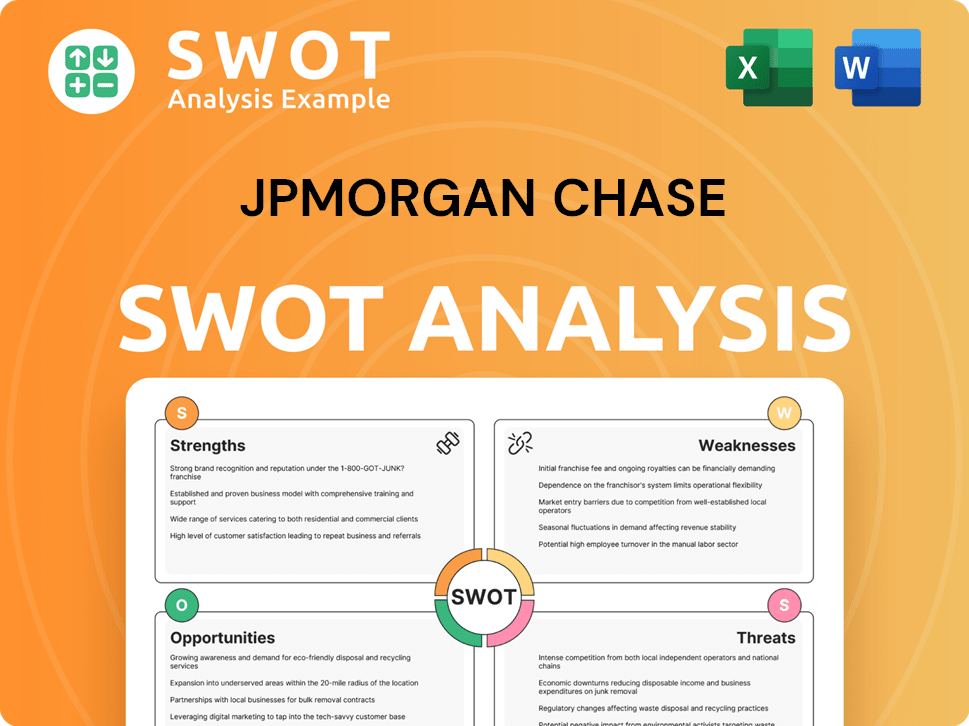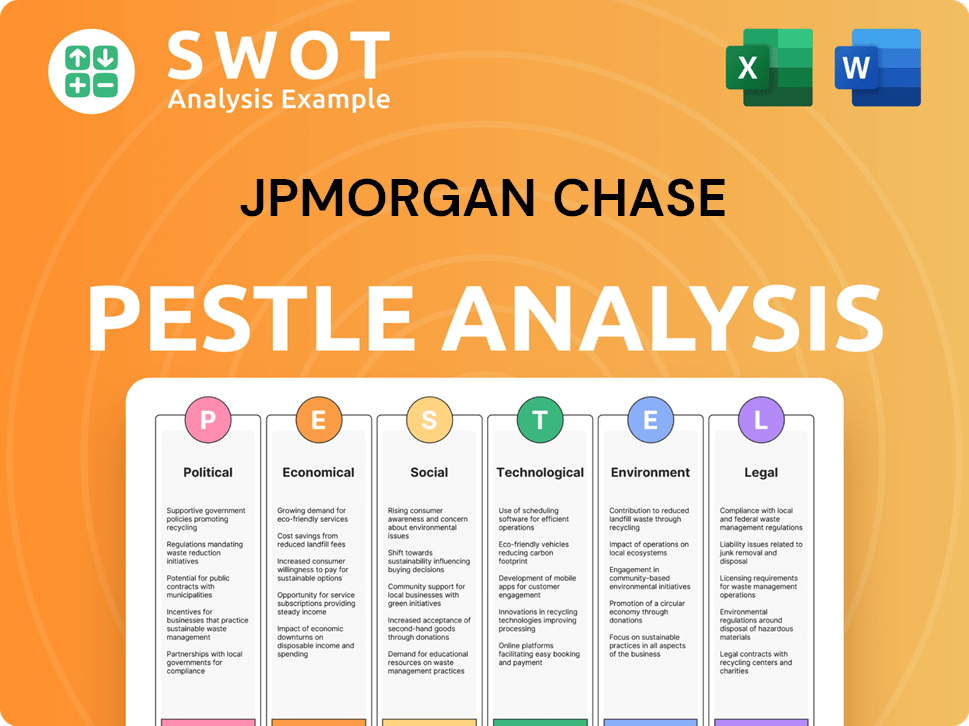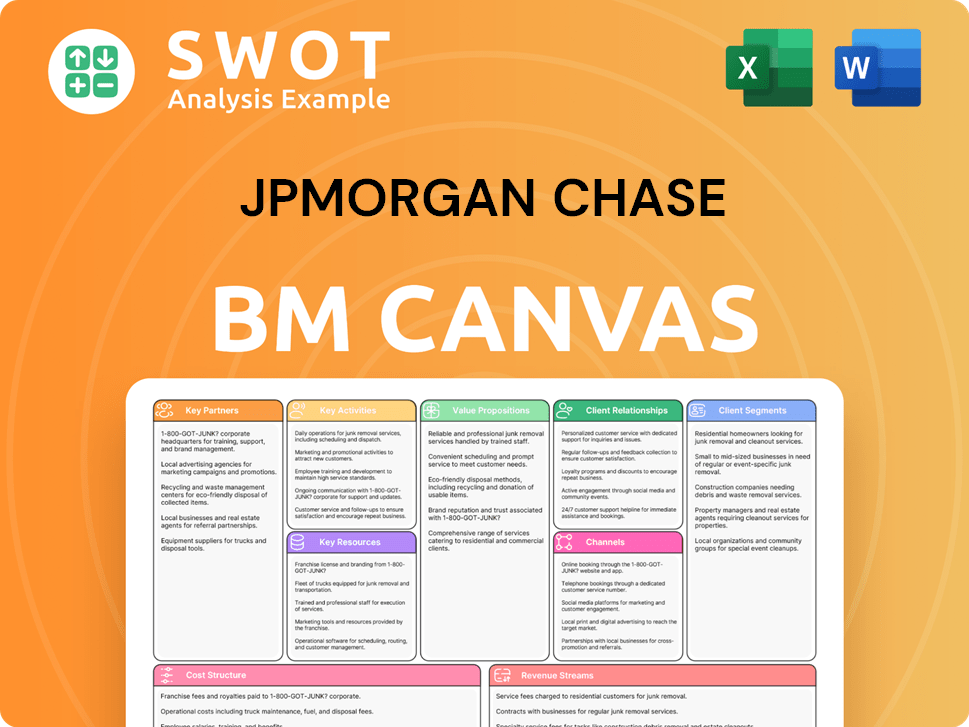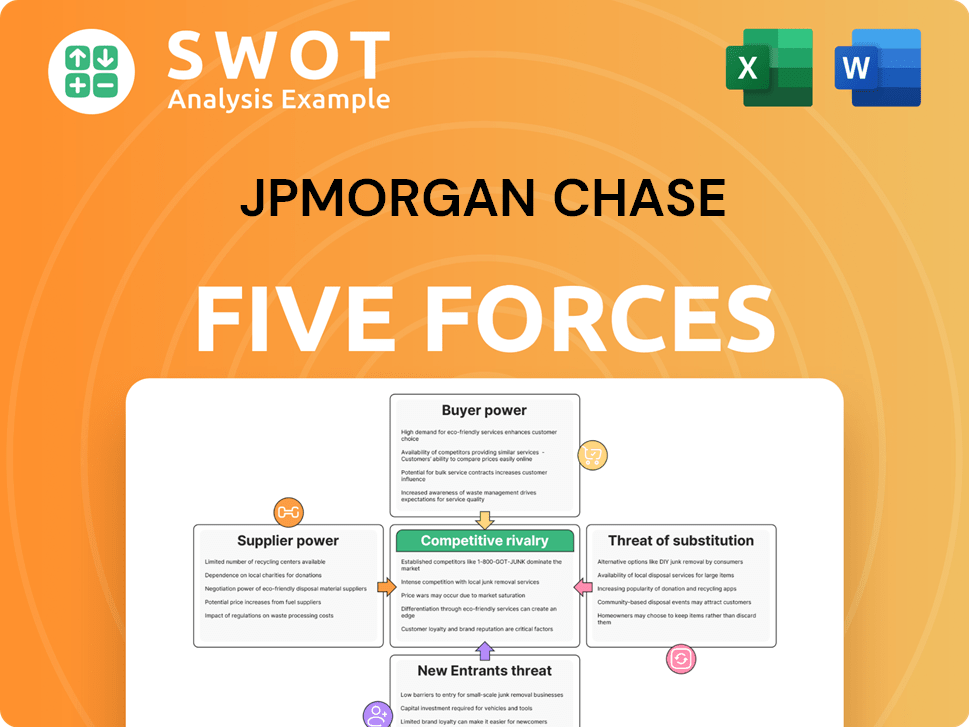JPMorgan Chase Bundle
Who Really Owns JPMorgan Chase?
Unraveling the ownership of JPMorgan Chase is key to understanding the behemoth's influence in today's financial world. From its humble beginnings to its current status as a global financial powerhouse, the evolution of JPMorgan Chase SWOT Analysis reveals a complex ownership structure. Understanding who controls this financial giant is crucial for anyone looking to navigate the intricacies of the market.

This exploration into Chase Bank ownership will uncover the major players behind JPM stock, from institutional investors to individual Chase shareholders. We'll investigate the influence of JPMorgan Chase executives and the board of directors, providing insights into who controls JPMorgan Chase's board of directors and the company's strategic direction. Discover the answers to questions like "Who is the CEO of JPMorgan Chase?" and "Who are the major shareholders of JPMorgan Chase?" to gain a complete understanding of this financial titan.
Who Founded JPMorgan Chase?
The story of JPMorgan Chase & Co. is a complex one, stemming from a long series of mergers and acquisitions. This makes understanding its 'founding ownership structure' a fascinating look at how financial institutions have evolved. The primary predecessors of the modern entity are J.P. Morgan & Co. and Chase Manhattan Corporation.
J.P. Morgan & Co. began in 1871 with J. Pierpont Morgan, a dominant figure in American finance. His initial ownership was absolute, reflecting the private banking model of the time. Similarly, the Chase Manhattan Corporation has roots in The Bank of The Manhattan Company, founded in 1799 by Aaron Burr, and Chase National Bank, established in 1877 by John Thompson. These banks started with ownership concentrated among wealthy individuals and families.
The founders and early owners of these institutions played a crucial role in shaping their future. The vision of the founding teams, whether it was Burr's focus on public utility or Morgan's emphasis on industrial finance, directly influenced how control was distributed. Those with the most capital held the most power, setting the stage for the financial powerhouse that JPMorgan Chase is today.
Founded in 1871 by J. Pierpont Morgan.
Evolved from The Bank of The Manhattan Company (1799) and Chase National Bank (1877).
Concentrated among founders, wealthy individuals, and prominent families.
Initially informal, based on trust and reputation, evolving into formal partnership agreements.
Resolved through private negotiation among partners.
Burr's focus on public utility, Morgan's emphasis on industrial finance.
Today, JPMorgan Chase is a publicly traded company, and many people ask, 'Who owns JPMorgan Chase?' The ownership is distributed among institutional investors, such as investment firms and mutual funds, and individual shareholders. As of the latest filings, major shareholders include The Vanguard Group, BlackRock, and State Street Corporation. The company's market capitalization is substantial, reflecting its position as a leading financial institution. If you are interested in learning more about the company's strategic direction, you can explore the Growth Strategy of JPMorgan Chase.
Here are some key facts about JPMorgan Chase:
- JPM stock is traded on the New York Stock Exchange (NYSE).
- The current CEO is Jamie Dimon.
- The company has a vast number of employees, numbering in the hundreds of thousands.
- The headquarters of JPMorgan Chase is located in New York City.
- Major Chase shareholders include institutional investors.
JPMorgan Chase SWOT Analysis
- Complete SWOT Breakdown
- Fully Customizable
- Editable in Excel & Word
- Professional Formatting
- Investor-Ready Format

How Has JPMorgan Chase’s Ownership Changed Over Time?
The evolution of JPMorgan Chase's ownership has been shaped by pivotal mergers and its status as a publicly traded entity. The merger of J.P. Morgan & Co. and Chase Manhattan Corporation in 2000 was a defining moment, creating the modern JPMorgan Chase & Co. This consolidation, executed through a share exchange, unified a diverse shareholder base. Following this merger, the company solidified its position on the New York Stock Exchange.
As of early 2025, the ownership of JPMorgan Chase is largely dominated by institutional investors. The company's structure reflects the influence of significant institutional holders, including mutual funds, index funds, and asset management firms. This ownership structure is typical for large, publicly traded companies, influenced by passive investment strategies that track major market indices.
| Institutional Holder | Approximate Shareholding (Early 2025) | Notes |
|---|---|---|
| Vanguard Group Inc. | Approximately 9.32% | A leading provider of index funds. |
| BlackRock Inc. | Around 7.50% | One of the world's largest asset managers. |
| State Street Corp. | Approximately 4.10% | Known for its significant holdings in various indices. |
Individual insider ownership, while present, constitutes a small fraction of the total shares compared to institutional holdings. Jamie Dimon, Chairman and CEO of JPMorgan Chase, holds a significant number of shares, aligning his interests with those of other shareholders. The influence of these major shareholders impacts company strategy and governance, often emphasizing long-term value creation and strong corporate governance. For more insights, read about the Target Market of JPMorgan Chase.
Institutional investors, such as Vanguard and BlackRock, hold the majority of JPMorgan Chase shares, influencing the company's strategic direction. JPM stock is widely held by institutional investors, reflecting their confidence in the company's long-term prospects. Jamie Dimon, as a significant individual shareholder, aligns his interests with those of other shareholders.
- The merger in 2000 was a pivotal event.
- Institutional investors drive long-term value.
- Individual insider ownership is a small fraction.
- The company's governance is influenced by major shareholders.
JPMorgan Chase PESTLE Analysis
- Covers All 6 PESTLE Categories
- No Research Needed – Save Hours of Work
- Built by Experts, Trusted by Consultants
- Instant Download, Ready to Use
- 100% Editable, Fully Customizable

Who Sits on JPMorgan Chase’s Board?
The current Board of Directors of JPMorgan Chase & Co. is pivotal in the company's governance. As of mid-2025, the board includes both executive and independent directors. Jamie Dimon serves as Chairman and Chief Executive Officer, holding a key position. The majority of the board consists of independent directors, chosen for their expertise in areas such as finance and risk management. These independent directors do not represent specific major shareholders.
The board oversees management and represents shareholder interests. The composition of the board is designed to ensure objectivity and mitigate conflicts of interest. The independent directors bring diverse expertise, which helps in making informed decisions. The structure of the board is a common practice in large public companies, promoting good corporate governance. The role of the board is crucial in maintaining the company's stability and representing the interests of all stakeholders.
| Director | Title | Key Responsibility |
|---|---|---|
| Jamie Dimon | Chairman and CEO | Oversees all aspects of the company |
| Linda B. Bammann | Lead Independent Director | Ensures independent oversight of the board |
| Other Independent Directors | Various | Provide expertise in finance, risk, and other areas |
The voting structure of JPMorgan Chase follows a one-share-one-vote principle. Each share of common stock grants one vote on shareholder matters, such as director elections and executive compensation. There are no special voting rights. Major institutional investors collectively hold significant voting power. The aggregated votes of the largest institutional investors can heavily influence shareholder vote outcomes. If you're wondering about the history of JPMorgan Chase, understanding its governance structure is key.
The voting structure is straightforward, with each share carrying one vote. This ensures a democratic process for shareholders. Major institutional investors have significant influence due to their large shareholdings.
- One-share-one-vote principle.
- Significant influence from institutional investors.
- Focus on shareholder interests.
- Transparent voting process.
JPMorgan Chase Business Model Canvas
- Complete 9-Block Business Model Canvas
- Effortlessly Communicate Your Business Strategy
- Investor-Ready BMC Format
- 100% Editable and Customizable
- Clear and Structured Layout

What Recent Changes Have Shaped JPMorgan Chase’s Ownership Landscape?
Over the past few years, the ownership structure of JPMorgan Chase has remained largely consistent, with institutional investors holding a dominant position. The company has consistently engaged in share buyback programs to return capital to shareholders, aiming to boost earnings per share. For example, in 2024, JPMorgan Chase announced a significant share repurchase initiative, reflecting its strategy to optimize its capital structure and increase shareholder value. This approach, however, doesn't typically cause major shifts in the proportional ownership among significant institutional holders, unless large investors decide to sell their shares.
Mergers and acquisitions have historically been a driver of JPMorgan Chase's expansion; however, recent activity has focused more on strategic growth into new markets rather than fundamental changes to the parent company's ownership. The acquisition of First Republic Bank in May 2023, while a notable event, didn't significantly alter JPMorgan Chase's ownership structure. Instead, it expanded its asset base and market presence. The leadership remains stable, with Jamie Dimon as Chairman and CEO, ensuring continuity in strategic direction and investor confidence. This stability is a key factor in how investors view the company.
| Key Aspect | Details | Recent Data |
|---|---|---|
| Share Buybacks | Ongoing programs to repurchase shares. | Announced share repurchase program in 2024. |
| Institutional Ownership | Dominant ownership by institutional investors. | Index funds and ETFs hold a significant portion of shares. |
| Leadership Stability | Jamie Dimon continues as Chairman and CEO. | Provides continuity in strategic direction. |
Industry trends are also impacting the ownership dynamics. The rise of passive institutional ownership, with index funds and ETFs holding increasing stakes, is notable. This can lead to a more stable ownership base but potentially less direct engagement on specific corporate governance issues. There's also a growing emphasis on ESG factors, influencing shareholder engagement. The Growth Strategy of JPMorgan Chase provides further insights into the company's strategic direction and how it navigates these trends.
Institutional investors are the primary owners of JPMorgan Chase. These include investment firms, mutual funds, and other financial institutions. The ownership structure is relatively stable, with no major shifts in recent years.
Major shareholders of JPMorgan Chase include large institutional investors. These investors hold significant stakes in the company, influencing its strategic decisions and governance.
Share buybacks reduce the number of outstanding shares, potentially increasing earnings per share. This strategy aims to boost shareholder value and optimize the company's capital structure.
Jamie Dimon's continued leadership as Chairman and CEO provides stability. This continuity is crucial for investor confidence and the company's long-term strategic direction.
JPMorgan Chase Porter's Five Forces Analysis
- Covers All 5 Competitive Forces in Detail
- Structured for Consultants, Students, and Founders
- 100% Editable in Microsoft Word & Excel
- Instant Digital Download – Use Immediately
- Compatible with Mac & PC – Fully Unlocked

Related Blogs
- What are Mission Vision & Core Values of JPMorgan Chase Company?
- What is Competitive Landscape of JPMorgan Chase Company?
- What is Growth Strategy and Future Prospects of JPMorgan Chase Company?
- How Does JPMorgan Chase Company Work?
- What is Sales and Marketing Strategy of JPMorgan Chase Company?
- What is Brief History of JPMorgan Chase Company?
- What is Customer Demographics and Target Market of JPMorgan Chase Company?
Disclaimer
All information, articles, and product details provided on this website are for general informational and educational purposes only. We do not claim any ownership over, nor do we intend to infringe upon, any trademarks, copyrights, logos, brand names, or other intellectual property mentioned or depicted on this site. Such intellectual property remains the property of its respective owners, and any references here are made solely for identification or informational purposes, without implying any affiliation, endorsement, or partnership.
We make no representations or warranties, express or implied, regarding the accuracy, completeness, or suitability of any content or products presented. Nothing on this website should be construed as legal, tax, investment, financial, medical, or other professional advice. In addition, no part of this site—including articles or product references—constitutes a solicitation, recommendation, endorsement, advertisement, or offer to buy or sell any securities, franchises, or other financial instruments, particularly in jurisdictions where such activity would be unlawful.
All content is of a general nature and may not address the specific circumstances of any individual or entity. It is not a substitute for professional advice or services. Any actions you take based on the information provided here are strictly at your own risk. You accept full responsibility for any decisions or outcomes arising from your use of this website and agree to release us from any liability in connection with your use of, or reliance upon, the content or products found herein.